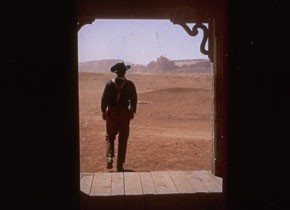The Big Sky
American Westerns of the 1950s
September 1 to October 1, 2006
To open the new season, the Film Museum presents 40 outstanding examples of a classic genre whose rediscovery on the big screen is long overdue. Some of the major works created by the great American directors will be screened during the Retrospective (with mostly new or restored prints) – films by John Ford, Howard Hawks, Anthony Mann, Budd Boetticher, Raoul Walsh, King Vidor, Nicholas Ray, Jacques Tourneur, Sam Peckinpah, Arthur Penn, and many others.
The show will also include some of the unconventional Westerns made by Austro-Hungarian émigrés such as Fritz Lang, Otto Preminger, Edgar G. Ulmer, Fred Zinnemann and André de Toth. All of these artists contributed to a comprehensive narrative which cultural historians sometimes compare to Shakespeare's dramatic oeuvre, the Iliad or the Nibelungenlied: the Western as America's national epic.
The Retrospective focuses on the era of the "extended 50s", from 1946 to 1962, the actual years when the Western reached its full maturity. Its speedy revitalization and transformation in the years immediately following the Second World War had many facets. The genre gained in colour (Duel in the Sun, Canyon Passage), in spatial breadth (Red River, Wagon Master), and above all in psychological complexity (Pursued, The Gunfighter). The American experience of war enabled unromantic, naturalistic representations of death and violence.
Rather than the triumphs, it is the wounds and crises of the Western hero which have become the centre of attention: "When he lost his credibility as a knight in shining armour, the hero had to become a tragic figure." (Georg Seeßlen) The readiness to use the genre allegorically in treating contemporary issues of American politics at home and abroad also reached its first climax. The Gunfighter Nation (Richard Slotkin) of the Cold War era recognized itself – with all its contradictions – in the legends and real conflicts of the "Wild West", the mid-to-late 19th century Gunfighter Nation.
Neither before nor afterwards were Westerns so "grown-up" and popular at the same time as they were in the 1950s. This double attraction made them the terrain of choice for some of the best actors and biggest stars of the era; the genre had definitely moved out of the realm of inglorious B-movies and offered an opportunity to undertake serious investigations of the damaged male psyche (as demonstrated, for example, by the James Stewart characters in the films of Anthony Mann), or to question the relationship between myth and truth (as in John Ford's films).
The ensemble of actors and actresses which one will encounter during this show almost resembles a Pantheon of American film acting, and testifies to a great variety of types and characters: Robert Mitchum and Marlon Brando (in his sole directorial effort One-Eyed Jacks), Henry Fonda and Marilyn Monroe, Gary Cooper and Montgomery Clift, Dean Martin and Marlene Dietrich... as well as John Wayne, the genre’s true icon and, at the same time, one of the most underrated actors in Hollywood history.
The claim to "rediscovery" which this Retrospective makes may seem puzzling, considering the cultural prominence of the genre it deals with. Yet the Western, which for generations of European cinephiles was the central movie genre, no longer has a presence in either the cinema or cultural debates.
At the same time, the subject matter of Westerns is discussed all over the world, and more controversially than ever before: America as a history of violence and democracy; as a dream of liberty and community; as a nightmare of conformism and racism; as a place of contradictions and land of beauty.
"The Big Sky” spreads out over the actual arena of the Western: the endless spaces, the abundance of land, the "sea of grass” and the "bloody grounds” which became the historic foundation for both the dream and the violence, as well as for the quickly spreading economic wealth which followed in their wake.
Public discourse and political philosophy in the USA return to this territory again and again – even today, more than a hundred years after it was completely conquered and settled by the descendants of Europe who were as prone to dreaming as to violence.
The Western shows us the American body politic struggling to find its self-image. What comes after the conquest? Which ideals of happiness, law and government should be implemented, and what methods are to be considered legitimate in the process? What repercussions do these methods have for the victors? And which myths are needed in order to keep the moral-ideological contradictions and class tensions "in balance"?
Nearly all the genre’s main motifs are tied to such political questions: the Indian Wars and racial hatred; the violent "taming" of the wide open towns on the Western frontier; the play of identities between gunfighter and sheriff; the economy of the pioneer wagon trains and cattle drives; the gold rush and the problem of lynch mobs; the relations to the "Third World" on the other side of the Mexican border; the class struggle between the new rulers and property owners – cattle barons, bankers, railroad tycoons – and the small settlers and sheep farmers who were robbed of their dreams; and, finally, the famous outlaw figures who became popular heroes by personifying resistance to exploitation.
In a letter dated December 21, 1877, the rancher John Henry Tunstall describes one of these historic outlaws, Billy the Kid: "He constantly speaks about Socialism and Capitalism and he carries a little book by an Englishman named Karl Marx around with him."
The Retrospective is supported by the US Embassy in Vienna. For the Film Museum’s book series KINO, Bert Rebhandl is preparing a new volume on the Western genre due for release in 2007.


